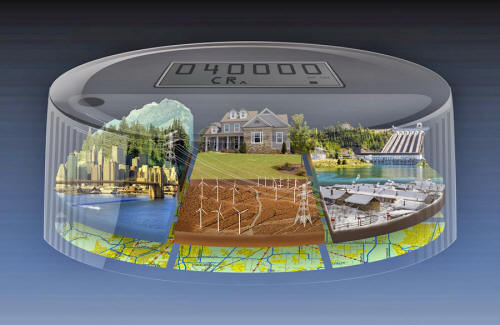by Brandon Turbeville
October 15, 2013
from
BrandonTurbeville
Website
Only one year after David Petraeus referred to the
publicly emerging technological structure of
Web-connected appliances and in-home devices as the
"Internet
of things" (IOT), applications are now
merging with the smart grid.
It is a dream come true
for the intelligence community looking for
opportunities to spy on the average American in
their homes, while globalists simultaneously advance
an eco-fascist Agenda 21-based energy control system
throughout the world.
This is being accomplished by the fact that the
new IOT expansion is extending from domestic
in-home devices such as refrigerators, toasters, and
televisions, and is moving toward the industrial
sector such as oil and gas, wind power, airlines,
health care, and railroads.
This new IOT application
would allow not only for the connection of machines
to the Internet, but to each other.
General Electric, the company blazing the trail of
the industrial IOT, recently,
"doubl[ed] the vertically-specialized hardware/software packages it offers to connect machines and interpret their data. The company hopes to make its mark by significantly reducing the amount of ‘unplanned downtime’ that industrial equipment undergoes, thereby bringing about economic benefits."
Yet GE is not the only major corporation that is jumping on board with the Industrial IOT.
As Singularity Hub states,
"the company has partnered with some of the usual enterprise technology suspects.
Intel is providing processors and management tools for the motley crew network. AT&T provides the Internet service, and Cisco software helps tackle the big data. GE brings knowledge of the industries and their equipment."
Brian Bradford, the marketing director of Smart Grid Solutions in GE’s Digital Energy division, in an interview with Singularity Hub, stated,
"At the end of the day, we see our strength in how to operate these systems, how the hardware and sensors work on these systems, and how you can take information and turn it into something that can add more predictive value for the [industrial] customer."
For those who are unaware of what the terms "Smart Grid" and "Smart City" mean, the Smart Grid is essentially a computerized system that allows the monitoring and control over energy use from power at the plant source to every appliance in the home.
Smart Grid technology is a major part of
United Nations Agenda
21 (see 'Just
Say No to Big Brother's Smart Meters - The Latest in
Bio-Hazard Technology'), the United Nations' plan to herd a
drastically reduced population into "human habitat
areas," meaning ultra-modern super cities with stack em’ and pack em’ dwelling structures and zero
contact with nature and the outside world.
Regardless, two of the new Smart Grid products being
offered by GE are the PowerUp program and the
GridIQInsight.
PowerUp is largely dedicated to the upgrades of software and hardware of wind farm operators.
GridIQInsight, however, is the more wide-ranging program of the two as it exhibits most of the aspects of Agenda 21 by monitoring "electrical usage, weather history, and equipment performance."
In addition, as Singularity Hub reports,
"the system can forecast problems that a utility grid might face, ideally resulting in fewer outages and thinner margins of surplus power."
Yet, regardless of the technology being developed such as that being mentioned above, according to many analysts the IOT will,
"have to employ a common set of protocols for ‘things’ to talk to one another."
GE, of course, is prepared for just such
an obstacle and apparently intends to use its
Predix software as the actual language base for
"machine-to-machine communication."
In addition,
Intel has announced their newest line of chips
-
Quark - which,
"are a fifth the size and consume a tenth the power of Atom, their smallest low-power chip to date."
This new chip line was developed with both "wearable" electronics and the IOT in mind.
Indeed,
Quark also has frightening implications regarding
the coming
implantable devices for which they were
also created.
While one could scarcely argue that the development
of a technology to better observe and analyze
overall energy use and efficiency, as well as
predict the potential problems the grid may face, is
a bad idea, one should also bear in mind that
maximizing energy output and improving its delivery,
use and distribution of energy is not what the Smart
Grid or any product developed by major corporations
like GE is about.
The fact is that the Smart Grid is nothing more than a major piece of the Agenda 21 total control system where humans will herded into major cities, driven off the countryside, and all energy consumption will be tightly monitored and dictated - if allowed at all.
The development of the technology such as that produced by GE is only one more step toward that goal.


